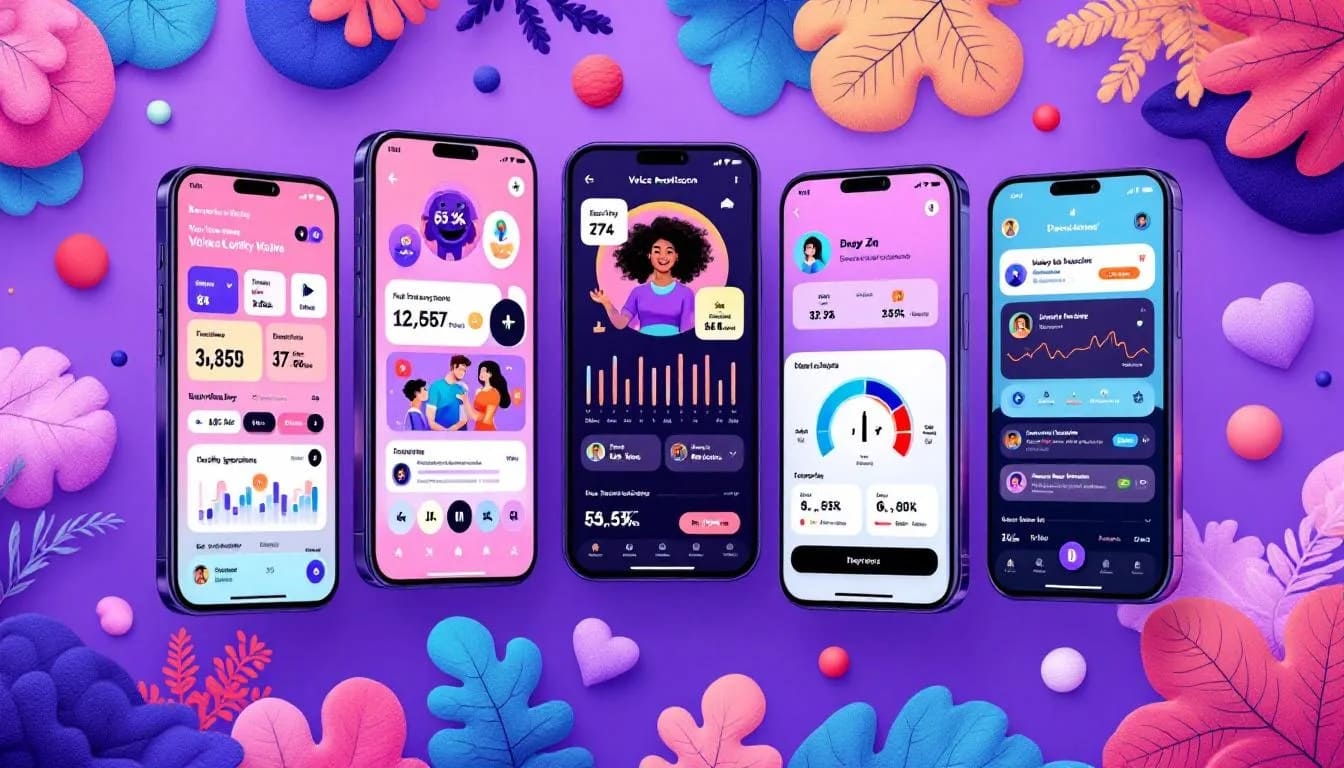Are you struggling to keep your mobile designs fresh and user-friendly for Gen Z? If your UI/UX feels outdated, you’re not alone. This generation demands more than just functionality — they crave designs that reflect their social-native behavior and preference for minimalism. In this post, we’ll dive into how Gen Z is reshaping UI/UX trends, helping you create mobile experiences that truly resonate.
Understanding Social-Native Behavior in Gen Z UI/UX
Social-native behavior refers to the intrinsic way Gen Z interacts with technology and digital platforms, shaped by growing up deeply embedded in a social-media-centric world. Unlike earlier generations, Gen Z does not use social media as a separate tool or an occasional outlet — social connectivity is woven into almost every digital experience they engage with.
This cultural shift profoundly influences Gen Z UI/UX expectations. Integration with social networks, instant sharing capabilities, and community involvement aren’t optional features — they’re essential components of any mobile interface targeting this group. Real-time interactions and fluid communication are prioritized, with Gen Z users expecting their apps to support constant connectivity and social validation.
Leading mobile apps embracing social-native features illustrate this trend. Take TikTok, for instance, which thrives on instant content sharing and live interactions, or Discord, which creates seamless community spaces with real-time messaging and voice communication. These apps showcase how embedding social dynamics directly into the UI dramatically enhances engagement and retention.
For designers, this means incorporating UI/UX patterns that facilitate immediate feedback loops, such as comment threads, live reactions, and share buttons that are easy to access. Gen Z values transparency and authenticity in interactions, so interfaces should encourage expression without friction. Additionally, leveraging push notifications smartly keeps users connected without overwhelming them, supporting real-time social connectivity without sacrificing user experience.
By deeply understanding social-native behavior, mobile designers can craft experiences that feel natural and compelling to Gen Z, accelerating app adoption and long-term loyalty.
Embracing Minimal Design for Gen Z Engagement
Minimal design isn’t just an aesthetic trend; for Gen Z, it’s a functional necessity. This generation’s fast-paced lifestyle and information overload foster a craving for simplicity and clarity in digital interfaces. Minimalism in UI/UX means reducing clutter, emphasizing essential features, and prioritizing user tasks.
At its core, minimal design principles for mobile center around clean layouts, ample white space, concise typography, and a limited color palette that guides attention without distraction. This approach aligns perfectly with Gen Z’s preference for fast, distraction-free experiences. They want to accomplish goals efficiently without navigating through overwhelming menus or excessive visual noise.
Comparing cluttered versus minimal UI elements reveals stark differences in engagement. Overly complex apps can frustrate users who want quick interactions, leading to drop-offs. Conversely, minimal interfaces streamline decision-making, making navigation intuitive and reducing cognitive load. For example, apps like Instagram have gradually shifted toward more minimalist designs by prioritizing visuals and simplifying navigation, boosting user engagement.
To balance aesthetics with functionality, designers should focus on prioritization — what functions do users need most? Which features can be hidden behind menus or accessible via gestures to maintain a clean interface? Use of progressive disclosure and smart iconography helps keep the UI sleek while preserving full functionality.
Actionable tips for adopting minimal design:
- Use clear hierarchy and spacing to guide the eye naturally.
- Limit color usage to 2-3 primary hues that evoke brand emotion.
- Employ micro-interactions to communicate status changes subtly.
- Design with scalability in mind for different screen sizes and contexts.
Through minimal design, mobile experiences become more accessible and compelling for Gen Z users, ultimately increasing satisfaction and time spent in the app.
Combining Social-Native Behavior with Minimal Design
The true challenge and opportunity for mobile designers lie in seamlessly blending Gen Z’s social-native behavior with minimal design. While social features demand connectivity and content richness, minimalism requires restraint and clarity. The key is balance — integrating social connectivity without compromising simplicity.
Strategies to achieve this fusion begin with subtle social cues embedded within a minimalist framework. Instead of overwhelming the screen with extensive social feeds or numerous buttons, designers can incorporate social-native elements like inline sharing, streamlined comment sections, and contextual notifications that appear only when relevant.
For example, the Snapchat interface embodies this synergy perfectly. It keeps the app glanceable and clean, with social interactions like Stories and chats accessible through simple swipes, not cluttered menus. This allows users to stay socially connected while enjoying fast, intuitive navigation.
Use cases also demonstrate the advantage of embracing these combined trends:
- Fitness apps that incorporate leaderboards and community challenges without compromising the clean tracker interface.
- E-commerce apps with minimal product pages but seamless social sharing options and user reviews integrated naturally.
- Educational platforms that use simple UI for lessons, enriched with real-time peer discussions and collaboration tools.
Tools and frameworks in 2025 that facilitate this integration include advanced design systems like Figma with plugins for social media components, and UI libraries such as Tailwind CSS that support minimalist aesthetics while allowing modular social feature implementation. Emerging technologies like React Native and Flutter now come with native social SDKs to embed sharing, chat, and real-time updates efficiently.
By thoughtfully combining social-native behavior with minimal design, mobile apps can meet Gen Z’s high expectations for connectedness and usability, building deeper emotional connections and superior user experiences.
Future Trends and Advanced Tactics in Gen Z UI/UX
Looking ahead, Gen Z UI/UX will continue to evolve alongside technology advancements and cultural shifts. Brands focused on winning this demographic must adopt emerging tactics and anticipate future expectations by leveraging innovative UI/UX trends.
One major trend is the rise of micro-interactions — subtle animations and feedback loops that enhance user engagement without adding complexity. These could be visual confirmations on social posts, tapping animations, or response-based UI changes that create a richer, more immersive experience.
Personalized content powered by AI is another frontier. AI algorithms analyze social behavior patterns, preferences, and usage history to tailor app interfaces and content feeds dynamically. This form of predictive UI anticipates user needs, offering contextually relevant features at the exact moment, boosting both satisfaction and retention.
Voice UI and gesture controls are increasingly pivotal in social contexts for Gen Z, who seek frictionless ways to interact without traditional typing or clicks. As voice assistants gain social intelligence, apps can facilitate hands-free sharing, dictation for comments, and gesture-based navigation — enhancing accessibility and social connectivity seamlessly.
Accessibility remains paramount as well. Minimal and social-native UI/UX frameworks should foster inclusivity, ensuring apps are easy to use by all users regardless of ability. Features like adjustable text sizes, contrast modes, and screen reader compatibility need to be baked in from the design phase.
In practice, leading brands in 2025 are harnessing a combination of:
- AI-driven dynamic UI adjustments based on mood or usage context.
- Multimodal inputs (voice, gesture, touch) optimized for social sharing flows.
- Continuous UX research loops with Gen Z testers to refine designs.
- Scalable accessibility tools built into design systems.
By embracing these future-forward UI/UX advancements, brands can position themselves as innovators in the Gen Z mobile design landscape, fostering loyalty and lifelong engagement.
Conclusion
Gen Z is not just another demographic — they are actively redefining how UI/UX should look and function on mobile devices through their social-native behavior and demand for minimal design. To stay competitive, brands need to embrace these trends with confidence. That’s where WildnetEdge comes in: as a trusted leader in innovative digital solutions, WildnetEdge helps you craft mobile experiences that resonate with Gen Z users and drive engagement. Ready to evolve your mobile design? Partner with WildnetEdge and lead the UI/UX revolution.
FAQs
Q1: How does social-native behavior influence Gen Z UI/UX design?
It prioritizes seamless social media integration, real-time sharing, and community-driven features to enhance interaction and engagement.
Q2: Why is minimal design important for Gen Z mobile experiences?
Minimal design reduces distractions, speeds up navigation, and aligns with Gen Z’s preference for clarity and efficiency in digital interfaces.
Q3: What are key strategies to combine social-native behavior with minimal design in UI/UX?
Integrate social features subtly without cluttering the interface, focus on intuitive navigation, and use clean visuals that support social interaction.
Q4: What future UI/UX trends should designers watch for in Gen Z mobile apps?
Look out for AI-driven personalization, voice and gesture controls, micro-interactions, and enhanced accessibility features.
Q5: How can WildnetEdge help brands implement Gen Z UI/UX trends?
WildnetEdge offers expert digital design and development services focused on creating engaging, socially connected, and minimalistic mobile experiences that appeal to Gen Z users.

Nitin Agarwal is a veteran in custom software development. He is fascinated by how software can turn ideas into real-world solutions. With extensive experience designing scalable and efficient systems, he focuses on creating software that delivers tangible results. Nitin enjoys exploring emerging technologies, taking on challenging projects, and mentoring teams to bring ideas to life. He believes that good software is not just about code; it’s about understanding problems and creating value for users. For him, great software combines thoughtful design, clever engineering, and a clear understanding of the problems it’s meant to solve.
 sales@wildnetedge.com
sales@wildnetedge.com +1 (212) 901 8616
+1 (212) 901 8616 +1 (437) 225-7733
+1 (437) 225-7733































